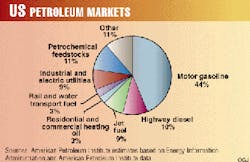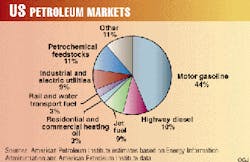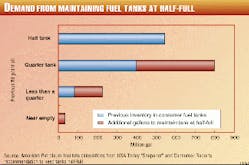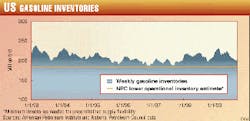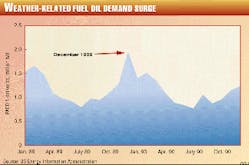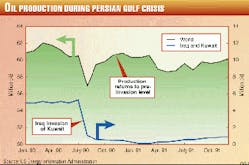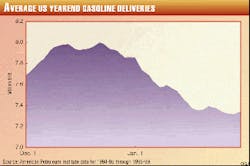Although fears about Year 2000 (Y2K) computer problems may cause the US public to buy more oil products in December, the likely demand scenarios appear to be within the supply capabilities of the US petroleum industry.
Some government and industry analysts are concerned that public hoarding of petroleum products could cause shortages that might not otherwise occur (OGJ, Aug. 23, 1999, p. 36).
Mobil Corp., in a Sept. 17 commentary published in newspapers, observed, "Panic buying by people on the eve of the millennium could set off a self-fulfilling prophecy...Most people, we believe, are too sensible to let panic ruin their New Year's."
Vulnerable markets
Of four major petroleum products, jet fuel and residual fuel oil seem the least susceptible to sudden surges in demand caused by stockpiling in anticipation of Y2K glitches.
Jet fuel commonly is supplied directly from refineries to airport terminals via pipelines, and terminals suitable for storing jet fuel have limited excess capacity. Thus, airlines lack capacity for large-scale stockpiling, and airlines have little economic incentive to invest scarce capital in surplus fuel stocks.
Residual fuel buyers have even less storage capacity and less incentive, with the exception of electric utilities not constrained by pollution restrictions.
The situation is somewhat different with distillate fuels. Residential and commercial heating oil customers usually get their tanks filled automatically, according to variations in degree days. Thus, a cold snap in December is a more likely source of increased demand than Y2K precautionary buying.
Diesel fuel customers, which include marketers and fleet owners, have considerable capacity for storage.
Moreover, the California experience with the October 1993 introduction of low-sulfur diesel showed that a new fuel slate combined with a second, simultaneous policy action (motor fuel taxes rose 4.3 ¢/gal) can possibly lead to sharp price spikes.
On the other hand, primary inventories of low-sulfur diesel in early October could be drawn down by roughly 10-15 million bbl before reaching recently observed lows, so that stockpiling by fleet owners and truck stop operators might easily be accommodated.
Finally, the demand for distillates is spread among several individual products with peak periods that are weakly correlated. For example, demand for highway diesel fuel is sensitive to industrial activity, whereas demand for high-sulfur heating oil depends importantly on weather and government fuel-assistance programs (Fig. 1).
It is unlikely that precautionary purchasing for such diverse purposes would be responsive to a single external stimulus such as Y2K fears. Thus, jet fuel, residual fuel oil, and distillates are not strong candidates for surge demand due to precautionary buying.
Gasoline is the fuel that is most susceptible to precautionary purchasing because the wholesale and retail customers have not only large amounts of unused storage capacity but also economic incentives to stockpile.
For example, gasoline is merely 5-10% of the cost of travel per mile in cars, but the travel benefits lost from fuel shortfalls would be enormous for most motorists. Hence, consumers arguably have strong incentives to purchase cheap insurance for fuel availability through stockpiling.
Diverse viewpoints on the effects of a demand surge at yearend suggest a number of differing scenarios. Following are some of these scenarios and the authors' observations about them.
Worst case
What if owners of 200 million vehicles in the US attempt to fill their tanks on Dec. 31?
With 180,000 outlets, this implies more than 1,000 motorists trying to fill up at each outlet in 1 day.
Could this be done, given that the supplies are available at retail outlets?
Assuming each of 180,000 outlets can serve 8 customers simultaneously and each customer can fill up in 10 min, each outlet can serve 48 customers/hr, or 1,152/day. Thus, perfect traffic management and 24-hr operation might suffice to barely fulfill consumer demand under this scenario.
What's the point? The point is this: Even this extreme Y2K scenario might not be a problem under the best of circumstances.
While the estimate of 180,000 retail outlets is probably high, and the assumption of 24-hr operation is an optimistic representation, these figures suggest something else.
The limit to filling the tanks of 200 million vehicles may not be gasoline supplies but road capacity.
For example, during Hurricane Floyd in September 1999, 2-3 million fleeing motorists were enough to bog down the interstate highways. Thus, in the case of extreme demand surges, the result probably will be traffic jams, not service stations running out of gas.
However, the implicit message is that a big surge in demand on (or near) New Year's Eve would cause trouble for the industry.
Accordingly, we consider a variation on this scenario in which daily demand continues to increase during the last 2 weeks of the year, with a large burst on New Year's Eve.
In what might be called our version of the worst-case scenario, some motorists make a late attempt to follow Consumer Reports magazine's advice to keep their tanks half full, while others rush to fill their tanks on New Year's Eve.
According to a survey reported in USA Today, 34% of motorists keep their tanks at least half full; 50% fill up when one quarter full, 14% when less than one quarter full, and 2% when empty.
Suppose that owners of 200 million vehicles, each with a 16-gal tank, become like the 34% who keep their tanks half full.
The one-time demand surge works out to 572 million gal. As Fig. 2 shows, the 4 million vehicles running on empty add 32 million gal; the 28 million running on less than a quarter tank are assumed to add 140 million gal, or an average of 5 gal/customer; and the 100 million with tanks one quarter full each add 4 gal, for a total of 400 million gal.
This increment can be compared with daily demand, which the US Energy Information Administration estimates as 8.61 million b/d for the fourth quarter of 1999, or roughly 362 million gal/day. (The authors' analysis of seasonal patterns shows that December volumes have been close to the fourth-quarter average.)
Thus, this last-minute effort to keep tanks half-full would result in a one-time surge equivalent to nearly 160% of 1 day's "normal" demand. Further last-minute fill-ups on Dec. 31 in this scenario would add substantial additional demand on the last day of the year.
How severe a strain would this place on the retail distribution segment?
The US's 180,000 retail gasoline outlets average perhaps as much as 30,000 gal of underground storage capacity. These tanks are typically half full, according to 1988 estimates of the National Petroleum Council (NPC). These numbers suggest retail outlet inventories of roughly 2.7 billion gal of gasoline, or more than 1 week's supply.
Thus, retail outlets might have enough gallons in the aggregate to meet even this worst-case demand scenario. Again, in the case of extreme demand surges, the result probably would be traffic jams, not service stations running out of gas.
Tightening markets
A second scenario is suggested by the president of the Petroleum Industry Research Foundation (PIRINC), Larry Goldstein, who expects stockpiling as cheap insurance against Y2K difficulties.
This could mean that the incremental retail demand would be spread uniformly over the 14-day period of Dec. 18-31. In that event, daily demand would rise by roughly 41 million gal/day.
However, the people most interested in precautionary stockpiling are likely to be resellers, especially independent marketers, which will make their purchases throughout November and December.
How much they would buy is hard to estimate, because it would depend on credit conditions, available storage capacity, and the relative cost of hedging in the futures market.
However, even an increase amounting to 4-5 million gal/day for 2 months would be small relative to primary inventories of gasoline.
Indeed, a comparison of currently available primary gasoline inventories with the levels identified by NPC as the minimum necessary implies considerable room for precautionary stockbuilding by resellers.
According to the NPC report, "US Petroleum Product Supply, Inventory Dynamics" (December 1998), lower operational inventories for gasoline are 160 million bbl for Petroleum Administration for Defense Districts (PADDs) I-IV and 25 million bbl for PADD V (Fig. 3).
In early October, stocks in PADDs I-IV were about 177 million bbl, and stocks in PADD V totaled about 27 million bbl, according to the American Petroleum Institute's Weekly Statistical Bulletin.
Thus, a considerable cushion for precautionary buying appeared available in all PADDs.
Furthermore, historical patterns show that US gasoline inventories have often risen another 5-10 million bbl during the fourth quarter, including 2-5 million bbl in PADD V.
For the US as a whole and its large regions, precautionary stockpiling by both wholesale and retail customers for gasoline does not appear problematic.
Of course, this assumes free flow of supplies within regions and does not consider numerous special or local circumstances that might impede meeting demands in a timely fashion.
For example, areas that will switch to federal Phase 2 reformulated gasoline on Jan. 1 could experience supply difficulties during the November-December buildup of Phase 2 gasoline supplies at refineries and terminals in late 1999.
Similarly, northeastern states that depend on gasoline imports from Europe may experience tighter-than-usual supplies in late autumn, because Europe also plans to introduce new fuels on Jan. 1, and this change could constrain Europeans' capacity to export.
Despite these cautionary considerations, the PIRINC scenario of precautionary buying as cheap insurance does not imply significant fuel supply problems this winter.
Industry flexibility
A third scenario can be inferred from the comments of API officials.
API Pres. Red Cavaney reports that the industry is used to responding to shifts in supply or demand through "redirecting the flow of products and by drawing on inventories as necessary."
Ron Quiggins, chairman of API's Y2K Task Force and an executive of Shell Oil Co., points out that the petroleum industry has large inventories and that the links between production and consumption are more flexible than the "real-time" nature of industries such as electric utilities.
Although API does not make production forecasts, these comments suggest an optimistic outlook regarding the risks posed by surge demand; both Cavaney and Quiggins anticipate no fuel supply threats from Y2K problems, implying that increased refinery output and drawdown of inventories would combine to match any surge in demand.
Additional supplies of gasoline (or other products) in December 1999 should be available from increased US production, because US refineries usually have excess capacity at that time of year.
For example, in December 1998, US refineries operated at 95% of capacity. Yet, during August 1998, US refineries had been able to operate at 100% of their reported operating capacity, suggesting a December surge production capability amounting to roughly 5% of capacity.
Overall, the trend in US petroleum refining has been one of capacity creep, in which incremental capacity to produce high-value transportation fuels has increased even as crude distillation units continue to be deactivated.
Worldwide, surge manufacturing capability appears proportionately greater. According to figures cited in API's Basic Petroleum Data Book, total world refinery utilization rates have been about 80-85%. By these data, the potential supply of gasoline and other product imports to the US is highly elastic.
Nonetheless, the principal source of additional gasoline supplies during December 1999 probably will be primary inventories on the grounds that surge production and surge imports would take time to reach various geographic markets. Fortunately, historical data suggest a substantial surge supply capability from this source.
In the last full week of December during 1989-98, average primary inventories (those maintained by refiners, pipelines, and large terminals) amounted to about 26 days' supply for jet fuel, 26-27 days' supply for gasoline, and 37 days' supply for distillates.
The NPC has estimated the lower operational inventory-the amount of primary inventories needed for unconstrained supply flexibility-as amounts roughly equivalent to 17 days' supply for jet fuel and 23 days' supply for gasoline and distillates.
Thus, "surplus" primary inventories during December 1989-98 amounted to about 3-4 days' supply of gasoline, 9 days' supply of jet fuel, and 14 days' supply of distillates.
Statistics on secondary inventories (those at small storage terminals and retail outlets) are less reliable, but a rough estimate is that "surplus" secondary inventories amount to about 3 days' supply of gasoline and larger amounts of distillates.
Hence, "surplus" primary and secondary inventories of gasoline combined could replace about 1 week's supply of gasoline and more than a week's supply of jet fuel and distillate fuels.
Surge experiences
Sharp increases in demand or partial loss of supplies, followed by supply responses to meet demand, have been commonplace in the petroleum industry in the past decade.
As one example, in 1989-90, a warm autumn followed by a cold snap caused a surge in demand for heating oil, first in Europe and then in the US.
Although US net imports of heating oil fell 40% in autumn 1989 relative to the previous year, sales of heating oil on the US East Coast increased about 17% in December 1989 relative to the previous year (Fig. 4).
For another example, the Aug. 2, 1990, invasion of Kuwait by Iraq eliminated about 8% of the world's supply of crude oil overnight.
However, surge production from Saudi Arabia, Venezuela, and the North Sea matched lost production in October, so that shortfalls occurred only in August-September.
During November 1990-March 1991, surge production of crude surpassed production lost (Fig. 5). More generally, the US supply system has experienced many demand surges, meeting these with increased supplies.
Analysis of data from the API Weekly Statistical Bulletin reveals large deviations in weekly US demand from monthly moving averages, even in normal times. For this purpose, demand was calculated as refinery production plus imports minus inventory change.
Deviations from trend were calculated as 1 week's demand divided by a 4-week, centered, moving average of the same series. On this basis, maximum deviations above the trend in demand amounted to 10% for gasoline and 17% for distillate fuel oils.
The maximum deviation for jet fuel was 28%, and for residual fuel oil, the deviation went as high as 35%. The largest deviation for the four products in the aggregate was 8%. A reasonable inference is that these data measure a lower bound on surge supply capability of the US distribution system.
There is evidence that even larger swings in US deliveries normally occur on a day-to-day basis, depending on the day of the week. For example, although daily deliveries data are not available, statistical analysis of longer-period data suggests that weekend deliveries from refineries, pipelines, and terminals tend to be the lowest of the week, and deliveries on weekdays tend to be the highest. Our analysis suggests that daily swings of
As a final note, it appears unlikely that meeting a demand surge in December would cause a shortfall in supplies for January. Fig. 6 shows the December-January seasonal pattern of gasoline deliveries, derived from API Weekly Statistical Bulletin data for the past 5 years.
It shows that, historically, deliveries have begun to slacken around Christmas and have fallen further during January. In fact, January has historically been the lowest month of the year for gasoline deliveries. This suggests a great deal of flexibility for the rebuilding of stocks from refinery production and imports, if necessary.
Versatility
The US petroleum distribution system is one of the most diverse and durable in the world.
Pipelines account for more than half of long-distance transportation of petroleum products and water carriers for more than a third, with the remainder accruing to railroads and trucks.
At the margin, these modes can substitute for one another, as was shown in the summer of 1999, when truck and barge movements partially compensated for the temporary shutdown of the Olympic Pipeline system in the northwestern US (see story, this page).
Short-distance transport is mainly by truck, but the numerous rail lines and waterways in the US permit some substitution here as well.
Whereas consumers of electricity, telephone, and cable TV services tend to be served by sole suppliers in each area, consumers of heating oil and propane often have choices.
Consumers of motor gasoline, diesel fuel, aviation fuels, and ship and industrial fuels commonly have multiple choices.
The versatility of the petroleum distribution system means that there are no critical links whose functional failure would cause the equivalent of an electricity blackout or the loss of communications services. Thus, while individual parts of the system may fail, the supply and distribution system as a whole is resilient.
Conclusion
Y2K is a one-time event that is unprecedented and worldwide.
Therefore, no one can know what will happen, and its impacts could be inconsequential or cataclysmic.
However, the demand scenarios reviewed here appear within the supply capabilities of the US petroleum industry.
Accordingly, the authors' expectation is that Jan. 1, 2000, will be just another New Year's Day for US petroleum products consumers.
The Authors
Thomas Hogarty is an adjunct economics professor at Virginia Polytechnic Institute and an oil industry consultant, specializing in gasoline marketing. During 1979-98, he was research manager and senior economist at the American Petroleum Institute. He previously was an economist for the US Senate budget and judiciary committees and for the US Federal Trade Commission and US General Accounting Office.
Ronald Planting is manager of information and analysis at the American Petroleum Institute. He has been with API since 1977 and has been editor of the API monthly statistical report since 1986. He recently became manager of the weekly statistical bulletin.
